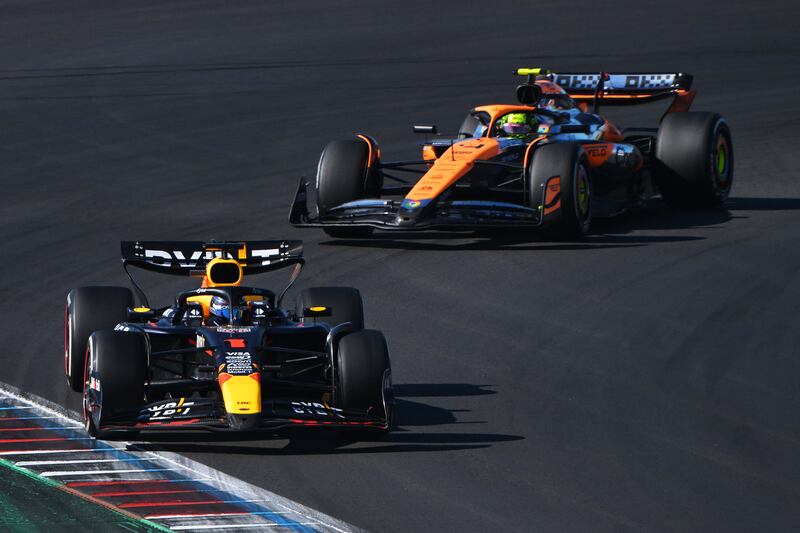While the dust has yet to settle on the controversy over Max Verstappen’s defence against Lando Norris’s overtaking at the US Grand Prix last Sunday, the two drivers will go at it once more this weekend in Mexico.
The issue raised by their battle in Austin remains highly contentious, however, and is in need of being addressed. If Formula One is to enjoy a championship fight between the two rivals, exploitation of flawed principles, confusion and subsequent accusations of inconsistency in stewarding will not do it any favours.
For the closing 10 laps in Texas, Verstappen and Norris, now separated by 57 points in the title fight with five races remaining, enjoyed a gripping head to head at the Circuit of the Americas.
The decisive moment came when Norris went to pass round the outside of turn 12. As he approached the corner, Verstappen took the inside line, forced Norris wide and both cars went off the track. Norris took the place but was given a five-second penalty for doing so because he was deemed to have gained an advantage by going off. Verstappen was not penalised and it cost Norris third place and vital championship points.
READ MORE
To be clear, according to the rules as applied by the stewards, Verstappen did nothing wrong. The stewards applied the penalty in accordance with the FIA’s Driving Standards Guidelines document. This is a brief designed as a reference point for drivers, officials and stewards and, as noted in its introduction, was called for by drivers.
“These guidelines are being issued by the FIA in response to a request from Formula One drivers for the FIA to confirm the factors that may be taken into account by the FIA stewards, when decisions are made in relation to certain driving incidents,” it reads.
Key in this case was the guideline focus on who is in front at the apex of the corner. In Austin it was Verstappen, so he was adjudged to have precedence, meaning for Norris to complete the move he would have to do so without illegally gaining an advantage by going off the track.
However, if Verstappen was deliberately going into the corner too fast, knowing he would be ahead at the apex but also that in so doing he would then go wide, or, having been in front at apex simply deliberately forcing Norris off, the Briton could not fail to lose the place. Norris could either back off, crash into him, or go wide and be penalised.

Entirely legal then but understandably a tactic that has garnered huge criticism. Norris was aggrieved and he was not alone.
Martin Brundle made reference to drivers knowing how the guidelines are interpreted and deliberately “gaming” the system. The former world champion Jenson Button made the same point, bluntly, to the Red Bull team principal, Christian Horner. “It seems your driver is very good at understanding the regulations,” he said. “And the problem [is] that we need better regulation of what is okay and what isn’t.”
Horner and Verstappen’s response was understandable, that they were following the rules. Yet in doing so they only highlighted that these rules – in the form of the guidelines – need re-examination.
Verstappen has been here before, not least when he defended in a similar fashion against Lewis Hamilton at Brazil in 2021. Since when it can be argued he has made the most of converting what is a position of defence going into a corner into one where he has the advantage from the car coming at him.
Norris was marginally ahead as they approached turn 12 but by late-braking and taking the apex, Verstappen was then considered the leading car, even if he knew full well he had no chance of making the corner on the track, and indeed, he did not. That scenario leaves almost any similar move to pass round the outside all but impossible without punishment. It is a dilemma that now needs an urgent solution.
The stewards copped flak for this and they are not helped by the inconsistencies involved. Oscar Piastri was given a penalty in Saturday’s sprint race after he pushed Pierre Gasly wide at the same corner in similar circumstances. But in doing so Piastri, unlike Verstappen, had managed to stay on track. George Russell was also penalised for pushing Valtteri Bottas wide at turn 12. Again, the stewards were sticking to the guidelines and Piastri summed up the frustration and confusion.
“I think my incident and Lando and Max’s looked very similar with the opposite penalties,” he said. “So, I’m sure we’ll have some questions.”
It is understood discussions on the subject are ongoing at the FIA and it will surely come up at the drivers’ briefing in Mexico, where those questions will be raised but perhaps Brundle’s judgment, from a former driver with more than a decade racing in F1 and a career since analysing and commentating, is the one most ominous in its assessment.
“As far as I’m concerned, the six-page guidelines, which have been signed off by the FIA, the drivers’ association and the teams, are a blueprint to dissuade overtaking, especially around the outside,” he said. – Guardian
- Sign up for push alerts and have the best news, analysis and comment delivered directly to your phone
- Join The Irish Times on WhatsApp and stay up to date
- Listen to our Inside Politics podcast for the best political chat and analysis














